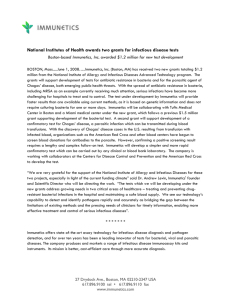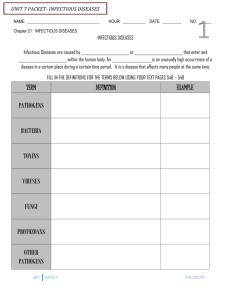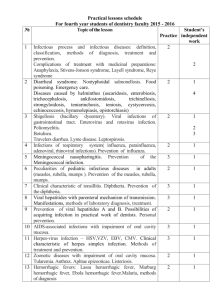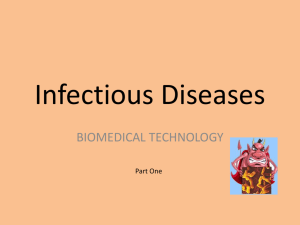Infectious Diseases - Life Science Academy
advertisement
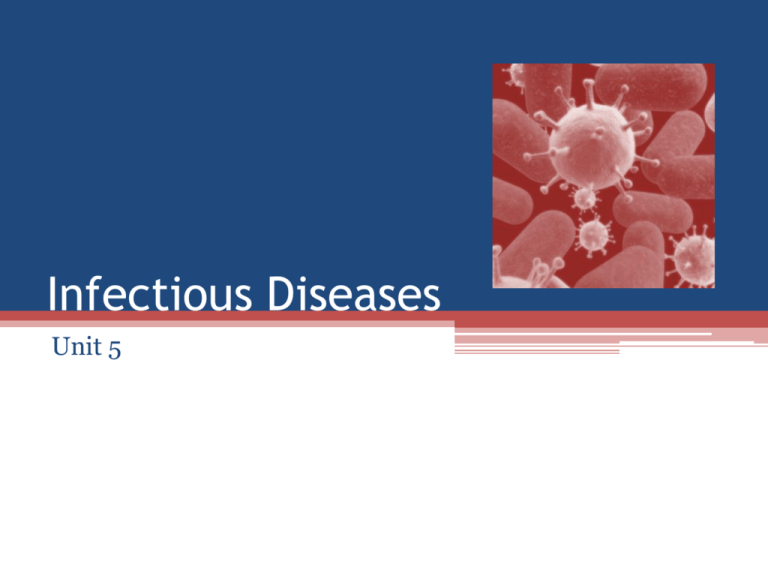
Infectious Diseases Unit 5 5.1 Key Terms & Essential Questions Antibody Aseptic Technique Bacillus Bacteria B Lymphocyte (B Cell) Coccus Contagious Fungus Gram Stain Helminthes Immunity Infection Microbiology Phagocyte Prion Protozoan Spirillum T Lymphocyte (T Cells) Transmission Virus 1. How are infectious diseases spread through a population? 2. What is aseptic technique? 3. How can an unknown sample of bacteria be identified? 4. How does the immune system function to protect the human body from foreign invaders? Infectious diseases • Caused by the entrance and reproduction of an infectious agent in a body ▫ Bacteria or virus ▫ The medical examiner who performed Anna Garcia’s autopsy pulled copies of Anna’s medical records before proceeding with the autopsy. Interestingly, the medical examiner discovered that Anna had been hospitalized just ten days prior to her death for a sickle cell crisis and subsequently was treated for an infection that was most likely acquired during her hospital stay. The medical examiner then noted that a page of the medical history is missing. Throughout this lesson, YOU will play the role of medical detectives in order to investigate Anna’s mystery infection. Ultimately, YOU will need to identify the exact pathogen, or infectious agent, responsible for Anna’s illness. Influenza Outbreak (1918-1919) Death and Devastation • Deadliest in modern history • More died from the flu than from World War I ▫ More than 25% of the U.S. population became sick ▫ 675,000 Americans died during the pandemic ▫ All age groups were affected, not just the young and elderly Spread of the Disease • First observed in Europe, the U.S. and parts of Asia ▫ Swiftly spread around the world ▫ Highest impact was along shipping and trade routes ▫ Spread quickly due to worldwide travel of troops returning from WW1 ▫ Estimates put the worldwide death toll at 21,642,274 Cause of Death • Extensive hemorrhaging in the lungs • Patients literally drowned in fluids • Researchers later discovered what made the pandemic so deadly • In many victims, the influenza virus had invaded their lungs and caused pneumonia Prevention • Quarantine of infected individuals • Mandatory use of face masks by all individuals when out in public Public Service Announcements: An important part of prevention Public Service Announcements: An important part of prevention How are the diseases spread? 1. ▫ ▫ 2. ▫ ▫ 3. 4. ▫ ▫ ▫ From person-to-person Potential to become epidemics. Flu, colds, measles, small pox, and the plague From animal-to-person Zoonotic Rabies, brucellosis (also known as undulant fever), staphylcoccosis, and streptococcosis. Through contaminated food, soil, water, or other material By disease vectors including: Mosquitoes Fleas Ticks How are people infected? • Contact with infected body fluids. ▫ Mucous from a cough or sneeze, blood, feces • Air, water, or food borne infectious agent • Contaminated surface ▫ Door knob ▫ Telephone Long term effects of infection • Bacterial and viral infections can damage the heart tissue • Viral infections can cause nerve damage ▫ suspected as a factor in the development of chronic neuromuscular syndromes including Multiple sclerosis Fibromyalgia Chronic Fatigue Syndrome • Both can lead to death 5.1.1 Contagious: Are you patient zero? 5.1.2: Infectious Disease Agents • Begin your detective work by exploring the different types of pathogens as well as examining specific examples of each type in order to identify what is plaguing Anna ▫ ▫ ▫ ▫ ▫ ▫ bacteria viruses fungi protozoa helminthes prions • Investigate a variety of diseases caused by infectious agents and use this information to determine the tests you will need to perform in the subsequent activities to fill in the missing pieces from Anna’s medical history What are Viruses? • Non-living particles that infect cells and cause disease • Requires antivirals, antibiotics have no effect • Very specific ▫ Must be able to attach to a cell to infect it • Contain genetic material that mutate ▫ Causes a change in the characteristics of the virus ▫ Allowing the virus to attach to new types of cells Viruses are not ALIVE!!! Living Things Viruses Use and need energy They don’t use neither need energy The have a life span They don’t have life span They grow They don’t' grow They reproduce REPLICATION, not reproduction (inside another organism) They develop They don’t develop They are organize They aren’t organized They are made up of cells They are made up normally from a genetic material and a capsid They adapt to the environment They adapt to the environment • How Viruses Work NPR video What are bacteria? 1. All are unicellular 2. All are prokaryotic - cells that lack nucleus (no nuclear envelope) (PRO = NO nucleus) 3. All have cell walls 4. Reproduce via fission or budding 5. Can live in both aerobic (with O2) and anaerobic (without O2) environments 6. Much larger than viruses 7. Usually have one of three different cell shapes: coccus, sprillum, bacili Endosymbiotic theory Ex: Streptococcus Ex: Lactobacillus Ex: Spirillium What shape? bacillus spirillu m coccus coccus bacillus spirillu m 5.1.2: Infectious Disease Agents: Type of Infectious Agent Bacteria Viruses Fungus Protozoa Helminthes Prions Disease Examples Modes of Does the Agent Transmission Require a Host for Reproduction? How the Agent is Treated Disease Cards Tuberculosis (TB) Type of Infectious Agent Bacteria Name of Infectious Agent Mycobacterium tuberculosis Symptoms of Disease The symptoms of TB disease depend on where in the body the bacteria are growing. Usually, TB bacteria grow in the lungs where they cause a bad cough that lasts 3 weeks or longer, pain in the chest, and coughing up blood or the phlegm from deep inside the lungs. Other symptoms include weakness, fatigue, weight loss, no appetite, chills, fever, and sweating at night. Diagnosis of Disease Skin test, blood test, chest X-ray, and sputum culture. Transmission of Disease TB is spread through the air from one person to another. The TB bacteria are put into the air when a person with TB disease of the lungs or throat coughs, sneezes, speaks, or sings. People nearby may breathe in these bacteria and become infected. Treatment of Disease Antibiotic treatment with isoniazid (INH), rifampin (RIF), or rifapentine (RPT). Strep Throat Type of Infectious Agent Bacteria Name of Infectious Agent Streptococcus pyogenes Symptoms of Disease General symptoms include throat pain, difficulty swallowing, red and swollen tonsils that often have white patches or streaks of pus on them, tiny red spots on the soft or hard palate, swollen and tender lymph nodes in the neck, fever, headache, rash, and fatigue. Diagnosis of Disease Throat culture, rapid antigen test, and/or rapid DNA test. Transmission of Disease Streptococcal bacteria are highly contagious. They can spread through airborne droplets when someone with the infection coughs or sneezes, or through shared food or drinks. You can also pick up the bacteria from a doorknob or other surface and transfer them to your nose or mouth. Treatment of Disease Oral antibiotic treatment with penicillin, amoxicillin, erythromycin, or azithromycin. Syphilis Type of Infectious Agent Name of Infectious Agent Symptoms of Disease Bacteria Treponema pallidum Primary syphilis – small sore on genitals Secondary syphilis – Rash that begins on trunk and covers entire body and may be accompanied by wart-like sores in the mouth or gential area. Muscle aches, fever, sore throat and swollen lymph nodes are also common. Latent syphilis – No symptoms Tertiary or late syphilis – Brain, nerve, eye, heart, blood vessel, liver, bone, and joint damage. Diagnosis of Disease Transmission of Disease Blood test for presence of antibodies, fluid culture from sores, or spinal tap. Spread through contact with an infected person's sore during sexual activity. The bacteria enter your body through minor cuts or abrasions in your skin or mucous membranes. Syphilis is contagious during its primary and secondary stages, and sometimes in the early latent period. It is also spread through direct unprotected close contact with an active lesion or through an infected mother to her baby during pregnancy or childbirth. Treatment of Disease Antibiotic treatment with penicillin. Giardiasis Type of Infectious Agent Protozoa Name of Infectious Agent Giardia lamblia parasite Symptoms of Disease A gastrointestinal disease with water, sometimes foul-smelling diarrhea that may alternate with soft, greasy stools, fatigue, abdominal cramps and bloating, belching gas with a bad taste, nausea, and weight loss. Diagnosis of Disease The infection is diagnosed with a stool sample. Transmission of Disease Giardia parasites live in the intestines of people and animals. Before the microscopic parasites are passed in stool, they become encased within hard shells called cysts, which allows them to survive outside the intestines for months. Once inside a host, the cysts dissolve and the parasites are released. Infection occurs when you accidentally ingest the parasites. This can occur by swallowing contaminated water, by eating contaminated food, or through person-to-person contact. Treatment of Disease Administration of medications specific to giardia infection (including metronidazole, tinidazole, nitazoxanide, and paromomycin). Malaria Type of Infectious Agent Protozoa Name of Infectious Agent Plasmodium parasite Symptoms of Disease Malaria causes damage to red blood cells which can cause serious and sometimes fatal complications. The disease is characterized by recurrent attacks with moderate to severe shaking chills, high fever, profuse sweating as the body temperature falls, headache, nausea, vomiting, and diarrhea. Diagnosis of Disease Blood test for the parasite. Transmission of Disease Microscopic parasites transmit the disease from person to person. A mosquito becomes infected by feeding on a person who has malaria and then transmits the malaria parasites to the next person the mosquito bites. Malaria can also be transmitted from mother to unborn child, through infected blood transfusions, and by sharing infected needles. Treatment of Disease Administration of antimalarial drugs. Cryptosporidiosis Type of Infectious Agent Protozoa Name of Infectious Agent Cryptosporidium parvum parasite Symptoms of Disease A gastrointestinal disease whose symptoms include watery diarrhea, dehydration, weight loss, stomach cramps or pain, fever, nausea, and vomiting. Diagnosis of Disease The infection can be diagnosed with an acid-staining test which identifies cryptosporidium under the microscope or a stool culture. Transmission of Disease The infection begins when you ingest the parasite which then travels to your intestinal tract and settles into the walls of your intestines. You can become infected with cryptosporidium by touching anything that has come in contact with contaminated feces. Methods of infection include swallowing or putting something contaminated in your mouth, drinking contaminated water, swimming in contaminated water and accidentally swallowing some of it, touching your hand to your mouth if you had comes into contact with a contaminated surface, or having close contact with other infected people or animals. Treatment of Disease Administration of anti-parasitic drug, anti-motility agents to slow down the movements of the intestines, and fluid replacement therapy. Creutzfeldt-Jakob Disease (CJD) Type of Infectious Agent Prion Name of Infectious Agent CJD Prion Symptoms of Disease CJD is marked by rapid mental deterioration, usually within a few months. Initial signs and symptoms typically include personality changes, anxiety, depression, memory loss, impaired thinking, blurred vision, insomnia, difficulty speaking, difficulty swallowing, and sudden jerky movements. As the disease progresses, mental symptoms worsen and people eventually lapse into a coma. Diagnosis of Disease Doctors commonly use an EEG, MRI, spinal fluid tests, and/or tonsil biopsies to diagnose the disease. Transmission of Disease CJD disease is caused by an abnormal version of a kind of protein called a prion. Normally the proteins are harmless, but when they’re misshapen they become infectious and can cause major problems on normal biological processes. Most people with CJD develop the disease for no apparent reason, but others who develop the disease have a family history of the disease or test positive for a genetic mutation associated with CJF. A small number of people have developed CJD after being exposed to infected human tissue during a medical procedure. This happens because standard sterilization methods do not destroy abnormal prions. Treatment of Disease No effective treatment exists for Creutzfeldt-Jakob disease or any of its variants. Ascariasis Type of Infectious Agent Helminth Name of Infectious Agent Ascariasis worm Symptoms of Disease After the ascariasis eggs are ingested, they hatch in the intestines and sometimes migrate through the bloodstream or lymphatic system into the lungs. An intestinal infection can cause abdominal pain, nausea and vomiting, diarrhea or blood stools, and/or fatigue. A lung infection can cause persistent cough, shortness of breath, and/or wheezing. Diagnosis of Disease Infection is identified by stool tests, blood tests, and/or imaging tests. Transmission of Disease A person must come into contact with soil mixed with human feces that contains ascariasis eggs. Treatment of Disease Administration of anti-parasite medications. Trichinosis Type of Infectious Agent Helminth Name of Infectious Agent Trichinella roundworm Symptoms of Disease When a person swallows trichinella larvae encased in a cyst, the digestive juices dissolve the cyst, releasing the parasite into the body. The larvae then penetrate the intestine, where they mature into adult worms and mate. At this stage, symptoms include diarrhea, abdominal cramps, and malaise. Later the adult female worms produce larvae that penetrate the intestinal wall, enter the bloodstream, and burrow into muscle or other tissue. This causes high fever, muscle pain and tenderness, swelling of the eyelids or face, weakness, headache, and sensitivity to light. Diagnosis of Disease Initial diagnosis relies on physical examination of the classic signs and symptoms, blood samples, and a muscle biopsy. Transmission of Disease People get trichinosis when they eat undercooked meat — such as pork, bear, walrus, or horse — that is infected with the immature form (larvae) of the trichinella roundworm. Treatment of Disease Administration of anti-parasite (anti-helminthic) medication. Tapeworm Type of Infectious Agent Helminth Name of Infectious Agent Tapeworm Symptoms of Disease Intestinal infections cause nausea, weakness, loss of appetite, abdominal pain, diarrhea, weight loss and inadequate absorption of nutrients from food. Invasive infections result in fever, cystic masses or lumps, allergic reactions to the larvae, bacterial infections, and neurological symptoms including seizures. Diagnosis of Disease Stool sample analysis, blood test, and/or imaging exam. Transmission of Disease Consumption of food or water contaminated with feces from a person or animal with tapeworm or ingestion of larvae cysts in meat or muscle tissue of an animal with a tapeworm infection. Treatment of Disease Administration of oral medications that are toxic to the adult tapeworm (including praziquantel, albendazole, and nitazoxanide). Common Cold Type of Infectious Agent Virus Name of Infectious Agent Rhinovirus Symptoms of Disease Symptoms include: runny or stuffy nose, itchy or sore throat, cough, congestion, slight body aches or a mild headache, sneezing, watery eyes, a low-grade fever, and mild fatigue. Diagnosis of Disease Physical examination. Transmission of Disease The virus enters your body through your mouth or nose. The virus can spread through droplets in the air when someone who is sick coughs, sneezes, or talks. But it also spreads by hand-to-hand contact with someone who has a cold or by using shared objects, such as utensils, towels, toys, or telephones. If you touch your eyes, nose, or mouth after such contact or exposure, you're likely to "catch" a cold. Treatment of Disease There is no cure for the common cold. Over-the-counter cold treatments do not treat the cold but can sometimes relieve symptoms. These include pain relievers, decongestants, and cough syrups. Flu Type of Infectious Agent Virus Name of Infectious Agent Influenza Symptoms of Disease Symptoms include fever, aching muscles (especially in the back, arms, and legs), chills and sweats, headache, dry cough, fatigue and weakness, and nasal congestion. Diagnosis of Disease Physical examination. Transmission of Disease Flu viruses travel through the air in droplets when someone with the infection coughs, sneezes, or talks. You can inhale the droplets directly, or you can pick up the germs from an object — such as a telephone or computer keyboard — and then transfer them to your eyes, nose, or mouth. Treatment of Disease Bed rest and hydration is usually the only treatment needed. Antiviral medications can be prescribed if taken soon after symptoms begin. These drugs may shorten the illness by a day or so and help prevent serious complications. Rotavirus Type of Infectious Agent Name of Infectious Agent Symptoms of Disease Virus Rotavirus Symptoms begin with a fever, followed by three to eight days of watery diarrhea and vomiting. The infection can cause abdominal pain as well. In adults who are otherwise healthy, a rotavirus infection may cause only mild signs and symptoms — or none at all. Diagnosis of Disease Diagnosed via a physical exam. Stool sample may be analyzed to confirm the diagnosis. Transmission of Disease Rotavirus is present in an infected person's stool several days before symptoms appear and for up to 10 days after symptoms subside. The virus spreads easily through hand-to-mouth contact throughout this time — even if the infected person doesn't have symptoms. Not washing your hands after using the toilet or changing a child’s diaper can cause the virus to spread to anything you touch, including food, toys, and utensils. If another person touches your unwashed hands or a contaminated object and then touches his or her mouth, an infection may follow. Sometimes rotavirus spreads through contaminated water or infected respiratory droplets coughed or sneezed into the air. Treatment of Disease There is no treatment for a rotavirus infection. The infection usually resolves within three to eight days. Primary treatment involves the prevention of dehydration. Histoplasmosis Type of Infectious Agent Fungus Name of Infectious Agent Histoplasma capsulatum Symptoms of Disease Several types of histoplasmosis exist. The mildest form produces no signs or symptoms, but severe infections can be life-threatening. Symptoms of the infection include fever, chills, headache, muscle aches, dry cough, and chest discomfort. Sometimes the infection causes joint pain and a rash. Diagnosis of Disease Inspection of lung secretions, blood or urine, biopsied lung tissue, and/or bone marrow. Transmission of Disease Histoplasmosis is caused by the reproductive cells (spores) of the fungus. The histoplasmosis fungus thrives in damp soil that's rich in organic material, especially the droppings from birds and bats The spores are extremely light and float into the air when dirt or other contaminated material is disturbed, so infection is most commonly transmitted during cleanup or demolition projects and to farmers and landscapers. Treatment of Disease Treatment usually isn't necessary if you have a mild case of histoplasmosis. But if your symptoms are severe or if you have the chronic or disseminated forms of the disease, you'll likely need treatment with one or more antifungal drugs. Ringworm (Tinea corporis) Type of Infectious Agent Fungus Name of Infectious Agent Dermatophytes Symptoms of Disease A circular rash on the skin that’s red and inflamed around the edge and healthy looking in the middle; slightly raised expanding rings of red, scaly skin on the trunk or face; and/or a round, flat patch of itchy skin. Diagnosis of Disease Skin scrapings or samples from the infected area are taken and looked at under a microscope. Transmission of Disease Ringworm is contagious and can be spread in the following ways: direct, skin-to-skin contact with an infected person; touching an animal with ringworm; contact with objects or surfaces that an infected person or animal has recently touched or rubbed against; or contact with infected soil. Treatment of Disease Administration of a prescription-strength topical antifungal or oral medication. Athlete’s Foot (Tinea pedis) Type of Infectious Agent Fungus Name of Infectious Agent Dermatophytes Symptoms of Disease Symptoms include itching, stinging, and burning between the toes; itching, stinging, and burning on the soles of the feet; itchy blisters; cracking and peeling skin, especially between the toes and on the soles of the feet; excessive dryness of the skin on the bottoms or sides of the feet; and/or toenails that are thick, crumbly, ragged, discolored, or pulling away from the nail bed. Diagnosis of Disease Skin scrapings or samples from the infected area are taken and viewed under a microscope. Transmission of Disease Athlete's foot thrives in thick, tight shoes that squeeze the toes together and create warm, moist areas between them. Damp socks and shoes and warm, humid conditions also favor the organisms' growth. The fungus is transmitted by sharing clothes or shoes with someone who has the fungal infection or walking barefoot in public areas where the infection can spread. Treatment of Disease Administration of antifungal medication. Public Service Announcements • Choose a communicable disease ▫ HPV, TB, HIV/AIDS, Flu, etc. • Or a related cause ▫ Wash your hands, childhood immunizations, flu vaccine • Poster series, Website, PowerPoint, Game, Brochure, Song, Dance, etc. • You MUST be able to advertise for your PSA ▫ E.g., a poster with your URL or link to your YouTube video • PSAs Due Friday • Monday: Representatives from the Green River District Health Department will select a few to post in their lobby! Outbreak: Anatomy of an epidemic Infection & Disease • Pathogen- infectious agent responsible for disease • Infection- pathogen invades and begins growing within a host • Disease- occurs if and when the invasion and growth of a pathogen impair bodily functions • To cause disease pathogens must 1. 2. 3. 4. Enter the host body Adhere to specific cells Invade and colonize tissues Inflict damage • Enter through openings to the body: mouth, eyes, nose, genital openings, breaks in the skin • Cause disease by ▫ Destroying cells of infected organisms by breaking the cells down for food ▫ Releases toxins (poisons) which destroy cells of infected organism • Must have access to new hosts to spread Highly contagious and virulent Contagious • Infectious agents that are easily transmitted Virulent • Infectious agents that are very likely to cause disease once transmitted The most troublesome infectious agents • Highly contagious and virulent 5.1.3: Isolating Bacteria • Patient samples contain a mix of bacteria • Bacteria grow in groups called colonies • On a growth media called agar • Isolation of individual colonies is necessary to study all of the possible pathogenic organisms for identification tests 5.1.3 Colony Morphology • http://www.microbelibrary.org/images/shoeb/c olonial%20morphology.html • Shape • Margin • Optical Properties • Pigment • Elevation • Texture Colony Shape Colony Margin Optical Properties Colony Pigment Colony Elevation Colony Texture • • • • Soft Granular Tenacious Mucoid Bacterial Isolation • A sample of each colony type streaked onto an agar plate to physically separate the colonies • You will isolate bacterial colonies from four samples, including Anna’s, and then complete a gross examination of the colonies from Anna’s sample 5.1.3 Bacterial Isolation • Streak 4 plates • Using aseptic techniques • Gross examination for identification test ▫ View and record results @ 24 hours ▫ View and record results @ 48 hours Kocuria rhizophila • Coccoid • halotolerant (acid tolerant) • Gram-positive • mammalian skin, soil, fermented foods, clinical specimens, fresh water and marine sediments Kocuria rosea • Gram-positive bacteria • Widespread in nature • Commonly found along with coagulasenegative Staphylococc us spp. on the skin of humans and mammals. Stigmatella aurantiaca • Rod shaped • Typically measuring about 5–8 μm long and 0.7–0.8 μm wide • Gram negative • Fruiting bodies • Found on rotting wood or fungi and soil 5.1.3 Bacterial Morphology Results Species Anna’s Sample K. rhizophilia K. roseus S. aurantiaca Size Margins Elevation Color Stigmatella aurantiaca Kocuria rhizophila Kocuria rosea Anna’s Sample Today • Epidemiologist • Any format, due Wednesday April 22th • Complete 5.1.3 • Begin 5.1.4 Part 1 • No microscopy • New Gram Stain presentation link online • Do the virtual lab • Complete to step 11 • Due Tuesday April 21st 5.1.4 Gram Staining: Gram (+) & Gram (-) • Bacteria can divided into 2 main groups • Based on reaction to Gram stain (set of dyes) ▫ Hans Christian Gram (1800s) ▫ Remains first step in classifying bacteria Purple- Gram positive Pink- Gram negative Gram Stain Process 1. Heat fix the slide so that bacterial cells are fixed to the slide. 2. Flood the slide with crystal violet dye. ▫ The individual crystal violet ions penetrate the thick peptidoglycan layer of the cell as well as the plasma membrane. 3. Rinse with water. 4. Flood the slide with iodine. ▫ (+) The iodine ions penetrate the cell wall and bind with the crystal violet. ▫ (-) The iodine ions and crystal violet react, forming a crystal violet-iodine complex that is a very large molecule and is insoluble in water. 5. Rinse with water. 6. Decolorize the slide with alcohol. ▫ (+) The alcohol causes water to leave the cell wall. Because of its larger size, the crystal violet-iodine complex is blocked from moving easily through the cell wall and thus is prevented from leaving the cell. ▫ (-) The alcohol disrupts and dissolves the outer membrane. Therefore the big crystal violet-iodine complex is able to leave the cell. 7. Rinse with water. ▫ (+) The crystal violet-iodine complex is still stuck inside the cell. The cell is therefore stained purple. ▫ (-) The crystal violet-iodine complex is washed away, leaving colorless, unstained cells. 8. Flood the slide with Safranin dye • Based on the ability of the bacterial cell wall to retain the crystal violet dye • It is retained or not is dependent on the type of bacterial cell 5.1.4 Gram Staining 1. 2. 3. 4. 5. 6. 7. Cells Alive Website: Examine bacterial structure Draw and label bacteria cell Include function Skip. Completed. Completed. Slides: Cocci Gram positive, Cocci Gram negative, bacillus, salmonella spp. 8. Sketch: Always label and include name and magnification 9. Slides: E. coli, Streptococci spp. 10. Sketch and Record Shape and Gram Status Transfer Fix Crystal Violet Dye (sit for 1m) Rinse Iodine (sit for 1m) Rinse Alcohol (rinse for 15-30s) Rinse Safranin (sit for 30s) Gram positive bacteria differ from Gram negative bacteria in the structure of their cell walls. The cell walls of Gram positive bacteria are made up of 20x more peptidoglycan, a polymer made of sugar and amino acids- which absorbs and retains crystal violet dye Gram (+) Bacteria ▫ Safranin penetrates the cell, but since it is a lighter color than the crystal violet-iodine complex, it is not visualized over the purple color of the crystal violet-iodine Gram (-) Bacteria ▫ Safranin penetrates the cell and stains the cell a reddish-pink color Design your own Bacteria Experiment • In your journal… ▫ Write your research question Antibacterial soap Hand sanitizer Test different surfaces ▫ Write your hypothesis ▫ Describe your experiment Each person has 1 petri dish and 2 sterile swabs Can work alone or with a partner ▫ Include a data table How will you measure your results? What data will you collect? • Get my OK • Proceed!!! Bacteria Experiment: Record Growth • After 24 hours ▫ Diagram each dish/section Draw exactly what it looks like Include measurements of each colony Take notes on appearance • After 72 hours ▫ Return to diagram after 24 hours ▫ Add additional growth and measurements in a different color 5.1.5 Bacterial Identification • Identification based on many factors ▫ ▫ ▫ ▫ Cell and colony morphology Chemical composition of cell walls Biochemical activities Nutritional requirements • Most definitive way to identify bacterial species ▫ Determine what growth media the bacteria will grow on ▫ Identify the end products of their metabolic processes Wastes they excrete ▫ Many tests are performed • Anna’s bacterial sample is a Gram negative rodshaped bacteria ▫ You will analyze the results of various biochemical tests ▫ To identify the unknown bacterial species Biochemical Tests Performed on Anna’s Sample Type of test performed: Result: Ornithine Decarboxylase Test Positive Citrate Test Positive VP test Positive Oxidase Test Negative Lysine Decarboxylase Test Positive H2S Test Negative Pigmentation Red Glucose Fermentation Test Positive Lactose Fermentation Negative Indole Test Negative Urease Test Negative Nitrate Reduction Positive Arabinose Test Negative Motility Test Positive Gelatin Hydrolysis Positive Catalase Test Positive Serratia marcescens • It is motile • Discovered by Bartolomeo Bizio in 1819. Named after Italian physicist named Serratia. • Found in places such as dirt, supposedly “sterile” places, and the subgingival biofilm of teeth. • pH levels 5-9 • Commonly found in patients with catheters. • Look on wikipedia lol • Investigate the basic structure and function of the immune system • With a team of three or four, create a board game or a children’s book that showcases what happens when an antigen (foreign invader) enters the body and how the body’s immune system fights off this invasion. • Make sure, at minimum, to include the following terms in your book or game. ▫ ▫ ▫ ▫ ▫ ▫ ▫ ▫ ▫ ▫ Non-specific defense Specific defense Skin Nose hair Mucus Inflammation B-cells Antibodies T-cells Phagocytes



